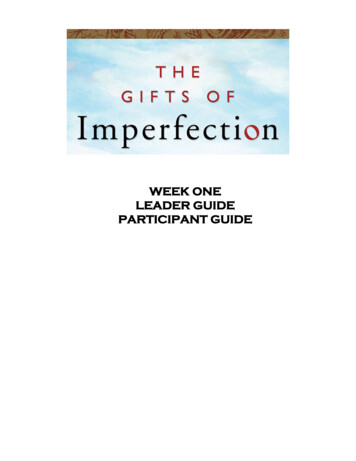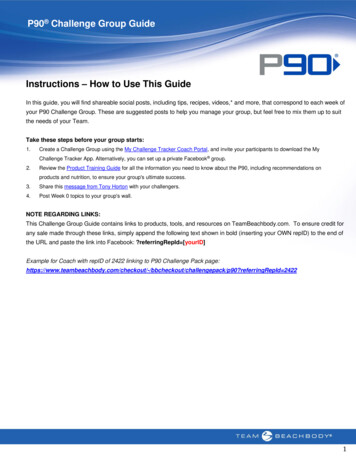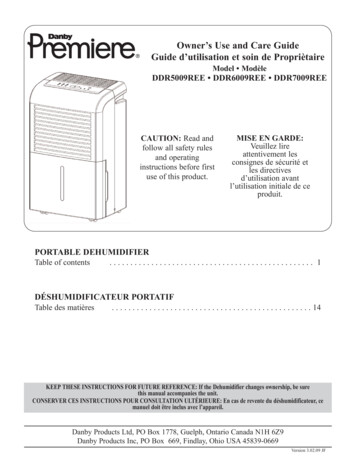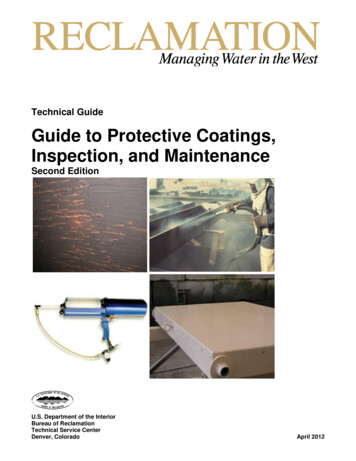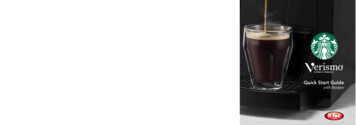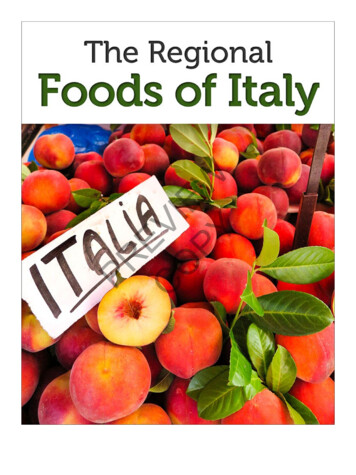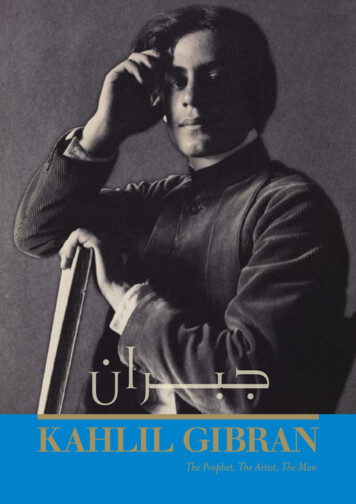
Transcription
A free exhibition presented at theState Library of New South Wales4 December 2010 to 20 February 2011Exhibition opening hours:9 am to 8 pm Monday to Thursday,9 am to 5 pm Friday, 10 am to 5pm weekendsMacquarie Street Sydney NSW 2000Telephone (02) 9273 1414Facsimile (02) 9273 1255TTY (02) 9273 1541Email library@sl.nsw.gov.auwww.sl.nsw.gov.auCurator: Avryl WhitnallExhibition project manager: Phil VernerExhibition designers: Beth Steven and Stephen Ryan,Freeman Ryan DesignExhibition graphics: Nerida Orsatti, Freeman Ryan DesignPrint and marketing graphics: Marianne HawkeEditor: Theresa WillsteedConservation services in Lebanon: David Butcher,Paris Art ConsultingInternational freight: Terry Fahey, Global Specialised ServicesPrinted in Australia by Pegasus Print GroupPaper: Focus Paper Evolve 275gsm (cover) and 120 gsm (text).The paper is 100% recycled from post-consumer waste.Print run: 10,000P&D-3499-11/2010ISBN 0 7313 7205 0 State Library of New South Wales, November 2010The State Library of New South Wales is a statutory authorityof, and principally funded by, the NSW State GovernmentThe State Library acknowledges the generous support of theNelson Meers FoundationNames of people and works in this exhibition have beenwesternised where appropriate for English-language publication.Unless otherwise stated, all works illustrated in this guide areby Kahlil Gibran (1883–1931), and are on loan from the GibranMuseum, Bsharri, Lebanon.Cover: Fred Holland Day, Kahlil Gibran with book, 1897,photographic print, National Media Museum/Science & SocietyPicture Library, UKAbove: Fred Holland Day, Portrait of Kahlil Gibran, c. 1898,photographic print, National Media Museum/Science & SocietyPicture Library, UK
FOREWORDKahlil Gibran’s visit to the State Library ofNew South Wales is both timely and fitting.On 31 October 1910, Gibran was arriving backin the United States of America after his artisticsojourn in Paris. One hundred years later, examplesof his life’s creative output — including workscreated in Paris — are arriving in Sydney on a newsojourn, to be displayed in a building, the MitchellLibrary, which is itself 100 years old. Gibran’sartworks and manuscripts are visiting the StateLibrary, which is renowned for its vast collection ofitems relating to previous and current generationsof artists and writers — it’s an excellent fit. TheLibrary also holds publications by Gibran, inseveral languages including English and Arabic.From a personal perspective, I was an avidreader as a young teen and I distinctly recalldevouring Gibran’s The prophet during that time.I am looking forward to reacquainting myselfwith Gibran — in particular The prophet — afterall these years. This exhibition also introduces usto his original artworks, which very few of us inAustralia may have previously seen. This is the firsttime that these works have travelled to Australia,on loan from the Gibran Museum in Bsharri,northern Lebanon.I would like to take this opportunity to thankthe passionate and indefatigable Professor FadiaGhossayn, President of the Australian LebaneseFoundation at the University of Sydney. Withouther patience and skills as an intermediary betweenthe Lebanese community of New South Wales andthe many contacts within Lebanon, this exhibitionand associated events would not have culminated insuch a wonderful celebration of literature and art.Kahlil Gibran had an enormous impact on manypeople around the globe.Now beautifully presented here at the StateLibrary of New South Wales, I first fell in love withthese artworks in Lebanon in July 2009. I felt itwould be wonderful if citizens in New South Walescould have the opportunity to share in the sheerbeauty of Gibran’s work.Khalil Gibran is the world’s third best-sellingpoet after Shakespeare and Lao-Tzu, making himone of the most widely read, culturally influentialpoets of all time.His watercolours and portraits, his poems inmanuscript, charcoal sketches from his days inParis as a student, photographs of his home townBsharri, notebooks from his years in London andBoston — all these works show us his essence. Ithas been said that his greatest work, The prophet,shaped the souls of many young Australians duringthe 1960s and 70s, as a counterculture bible for ageneration. And this doesn’t include its influencethroughout Europe, the United States, India andthe Arabic-speaking world.This exhibition in our own temple to literature,the grand Mitchell Library, is a taste of the richnessof Gibran’s art and an insight into his soul.I hope you will delight in this experience asmuch as I did.Gibran Khalil Gibran — writer, poet, artistand painter — is now in Sydney, on display at theState Library of New South Wales. This exhibitionshows this great philosopher as an artist, with eachwork revealing his insights.Gibran’s legacy is the powerful simplicity ofhis words, which continue to inspire those wholong for peace, search for love and strive forjustice. As he wrote in The prophet: ‘Work is Lovemade visible.’Gibran expressed his ideas through writing andthe visual arts, using black and white and colour.His subjects reflect his philosophy — he visualised‘Man’ in tragedy and sorrow, as well as in happinessand love. Gibran’s spirituality played a strong rolein his paintings, and he acknowledged the artisticculture he experienced in Paris as a young man, thegreat mystical poets of the East, and the Lebanesecountryside as some of his inspirations.Gibran believed that love is the key to all things:if a person has love, they are freed from greed,ambition, intellectual pride, blind obedience tocustom and awe of persons of higher social rank.In his Jesus, the son of man series, Gibrancreated his ‘Wanderer’ as a hero who embodiedhis message, and also captured the mood andatmosphere of his homeland, Lebanon, and itsabiding influence on his work.After 100 years, Gibran’s philosophy, art andpoetry still inspire people, and show why his legacycontinues to shine.From Bsharri to SydneyLebanon is renowned worldwide for its richcultural treasures and, more specifically, as beingthe birthplace and homeland of the genius of KhalilGibran. Along with his literary and artistic talent,Gibran is considered to be one of the greatestambassadors for Lebanese talent and cultureinternationally. His writing and paintings touchedpeople everywhere, leaving a brilliant legacy forthe world.This exhibition is an opportunity to celebratethe beauty and love in Gibran’s work, especially inhis remarkable paintings, on loan from the GibranMuseum — located in his home village, Bsharri —and exhibited for the first time in Sydney.The Gibran National Committee proudlyworks to fulfil our cultural mission in Lebanonand globally. We promote and protect our uniquebequest and, most importantly, communicateGibran’s philosophy worldwide. Therefore we arehonored to have our collection represented at theState Library of New South Wales, with the supportof the Lebanese Ministry of Culture represented byhis Excellency, the Minister Salim Wardy.Regina SuttonNSW State Librarian and Chief ExecutiveThe Hon Virginia Judge MPNSW Minister for the ArtsSalim WardyMinister of Culture, LebanonGibran National CommitteeBsharri, Lebanon
kahlil gibRanKahlil Gibran (1883–1931) was born Gibran KhalilGibran in Bsharri, Lebanon (part of Ottoman-ruledSyria at that time) to a poor but devout Maronite(Christian) family. When he was 12, his mothertook Kahlil, his older stepbrother and two youngersisters to America to seek a better life, leaving theirfather behind. They arrived at Ellis Island on 17 June1895 — a very small part of the wave of Lebaneseemigration into America in the late 19th century.The family settled in Boston’s South End amongstthe Syrian community, which included distant familyconnections, in an area renowned for overcrowdingand slum conditions. Gibran was the first and onlyone of his siblings to attend school, starting at theage of 13 in September 1895. For the next threeyears he learnt English and ‘the three Rs’. It wasprobably at this time that the spelling of his namewas westernised.Gibran’s own stories about his childhoodoften stressed his precocious and artistic nature —he seemed to spend a lot of time alone sketching,and his mother appears to have indulged him.Gibran’s artistic skills transformed the trajectoryof his life, deflecting his destiny away from whatcould have been a life of hard physical work andrelative obscurity.An art teacher at a local community centre Gibranattended out of school hours noticed his early artistictalent and brought him to the attention of a friend ofhers, Fred Holland Day, the first of two key figures inGibran’s life in the West.Fred Holland Day (1864–1933) was anindependently wealthy photographer and one ofthe leading lights of a Boston avant-garde movementcalled ‘the Visionists’. Meeting Gibran in December1896, Day mentored the good-looking exotic boyand used him as a model. Day found in Gibran anacolyte, a blank book, someone to be instructed andmoulded. Through Day, Gibran was introduced toa world of luxury and decadence, literature and art.He met established writers and artists. A whole newand exciting world opened up, setting his day-to-daylife in stark relief.Day encouraged the young Gibran to read widelyand introduced him to various artistic and literarymovements. What were then modern ideas wouldbe fundamental to Gibran’s later output: a fondnessfor nature, celebrating the power of love, a belief inthe unity of all religions, a preference for a personalreligion over organised religion, and an interest inreincarnation and the higher self.Gibran’s mother and stepbrother sent him backto Lebanon in August 1898, perhaps to remove himfrom Day’s influence; they may also have wantedto reinforce his Arabic heritage. Gibran began athree-year course of study at the Maronite Catholiccollege Madrasat-al-Hikmah in Beirut, where he wasintroduced to Arabic and French literature, as well asan Arabic translation of the Bible. Gibran and fellowstudent Youssef Howayek (1883–1962) produceda student magazine — Gibran was editor, designer,artist and chief contributor, while Howayek dealt withthe business side. In his final year, Gibran was veryproud of the fact that he was made the college poet— this gave him great confidence to pursue a living asa creative artist. During his time in Lebanon, Gibranalso met with his father, who was not particularlysupportive of his son’s artistic endeavours.Comforting angel, c. 1904PencilKAHLIL GIBRAN: THE PROPHET, THE ARTIST, THE MAN2
Portrait of Charlotte Teller, c. 1911Oil on canvas3KAHLIL GIBRAN: THE PROPHET, THE ARTIST, THE MANPortrait of the American painter Albert Ryder, 1915Red chalkKAHLIL GIBRAN: THE PROPHET, THE ARTIST, THE MAN4
Poetry is a deal of joy and pain andwonder, with a dash of the dictionary.Trees are poems that the earth writes uponthe sky. We fell them down and turn theminto paper that we may record our emptiness.All our words are but crumbs that falldown from the feast of the mind.The triangle, 1918Wash drawingQuotes above are from Kahlil Gribran’s Sand and foam, 19263KAHLIL GIBRAN: THE PROPHET, THE ARTIST, THE MANKAHLIL GIBRAN: THE PROPHET, THE ARTIST, THE MAN4
On completing his studies, Gibran travelled backto America by way of Athens, London, Munichand Paris, possibly funded by Fred Holland Day.While in Paris in April 1902, he learnt of the deathof his youngest sister, Sultana, at the age of 14. Shehad contracted tuberculosis, not uncommon inthe crowded slum conditions in Boston where thefamily was living. Gibran returned to find that hisstepbrother and his mother were also very ill. Botheventually died in 1903 — his brother of tuberculosisin March, his beloved mother of cancer in June —leaving Gibran and his sister Marianna. One can onlyimagine the psychological effect this would have hadon the sensitive 20-year-old Gibran.In 1904, Fred Holland Day, still a constant friendand guiding light, offered to let Gibran use hisHarcourt Building studio for Gibran’s first publicexhibition. The display opened on 30 April 1904 tofavourable critical attention. It was at the opening ofhis exhibition that Gibran met the next key figure inhis life, Mary Elizabeth Haskell (1873–1964).At 30, Mary Haskell was ten years older thanGibran, and an independently wealthy headmistressof her family’s private school in Boston. RecognisingGibran’s talents, Mary’s interest in him grew and shegradually took him under her wing and made himone of her protégés. Mary encouraged and fundedGibran’s visit to Paris from July 1908 to October1910, where he went to study art, and further develophis techniques and philosophy.Gibran enrolled at the Académie Julian (a largeprivate academy with a number of ateliers all overParis) in July 1908, when he joined the atelier ofJean-Paul Laurens. Here he learnt how to paint anduse colour, and improved his powers of observation.By early 1909 he was working in the studio ofPierre Marcel-Béronneau (of the Symbolist school).Shortly after this, Gibran seems to have given up on‘formal education’. He met up with his former fellowstudent Youssef Howayek, who was also in Paristo study art and sculpture. They hired models andspent hours studying the work of other artists theyadmired in the galleries and museums, immersingthemselves in their styles and techniques.It is possible that in December 1908, in thecompany of some professors and other students,Gibran visited Auguste Rodin in his studio. Rodinexpounded his philosophy of art and life and onequestion led him to talk about William Blake.Of all the impressions absorbed by Gibran duringhis Parisian sojourn none had a greater and morelasting influence on him than his [re-]discovery ofWilliam Blake. In Blake’s visionary work Gibranfound the support and confirmation for his ownearly ideas, and he owed more to the Englishmanthan to any other poet, artist, or philosopher.Bushrui and Jenkins, Kahlil Gibran: Man and poet, p. 101Gibran profited from Paris and, with the help ofhis teachers and friends and sheer hard work, hetransformed himself from a skilful draughtsman tosomeone who was not afraid to use colour and hadsome familiarity with oils, watercolours and pastels.While in Paris, he occasionally socialised withSyrian compatriots, meeting an older Lebanesewriter and political activist, Ameen Rihani(1876–1940), who introduced Gibran to other Syriandissidents living in Paris and to the world of Arabicpolitics, then in a dynamic stage of unificationbetween Arab states.Man in search of existence, c. 1920Wash drawing7KAHLIL GIBRAN: THE PROPHET, THE ARTIST, THE MANKAHLIL GIBRAN: THE PROPHET, THE ARTIST, THE MAN8
Gibran returned from Paris feeling he hadoutgrown Boston. Once again, encouraged andsponsored by Mary Haskell (who remained inBoston), he moved to Greenwich Village, New York,in April 1911. He eventually rented an artist’s studioin which he worked and lived, which he called ‘TheHermitage’. At this stage, he was still focused onfinding fame and fortune as an artist. A major artisticproject that Gibran conceived and initiated in Pariswas his ‘Temple of art’ series of pencil portraits(always Gibran’s best medium) of famous male andfemale artists of the day. He continued to add tothis series once he returned to America — in a 1914exhibition in New York there were 19 portraits ondisplay. However, by 1917 Gibran was finding moresuccess with his writing than his art, and this iswhere he started to concentrate his efforts.During his Parisian sojourn Gibran and Mary hadcorresponded regularly, and by the time he returnedfrom Paris they had formed a partnership of sorts,which essentially lasted for the remainder of Gibran’slife. He benefited from this devotion to his talent— Mary felt strongly enough about Gibran to be his‘muse’, English-language editor and ‘confidante’to the end of his life. She also financially supportedGibran. Along with paying for his visit to Paris, shealso paid the rent for his studios in Boston and NewYork and provided other funds until Gibran wasfinancially independent, a couple of years after thepublication of The prophet in 1923.New York was an exciting new prospect. Despitehis humble origins, by the time he reached histhirties Kahlil Gibran had become a charismatic man— small of stature but good looking, intense, politeand softly spoken. He had a ready and interestingopinion on most matters, but was also a goodlistener. He felt an abiding love for his homeland,yet could not bring himself to leave America, his landof opportunity. He was fascinated with all aspectsof the world around him yet often led an ascetic andlonely existence.Gibran continued his involvement with AmeenRihani and other Arabic activists, and became oneof the founding members of the Pen Club (’al-Rabitaal-Qalamiyya), writing for Arabic newspapers andassociating with the Syrian literati and other writersliving in New York. He gave popular poetry readingsin English to test new ideas for his publications, andbecame a darling of the matriarchal elite of New Yorksociety, at a time when alternative forms of religiousexpression were beginning to attract interest.Gibran was published in Arabic first, and laterin English. One of his first Arabic publications wasThe broken wings in 1912; and his first publicationin English was The madman in 1918. His Englishpublications veered from pessimistic to optimisticover time, with The prophet in 1923 considered themost confident and optimistic of all his writing.The prophet was Gibran’s third English-languagebook, and the twelfth of his 17 Arabic and Englishbooks published in his lifetime.In conception, it was the first of a trilogy: Theprophet was intended to cover man’s relationship toman, addressing the realities of human existence:birth, children, marriage, love, eating, work, pain anddeath. The second book, The garden of the prophet,was to address man’s relationship to nature; and thethird, The death of the prophet, would focus on man’srelationship to the divine. Gibran was working onThe garden of the prophet at the time of his death.The triad-being descending towards the mother-sea, 1923WatercolourKAHLIL GIBRAN: THE PROPHET, THE ARTIST, THE MAN10
Art is a step from nature towardsthe infinite.I long for eternity because thereI shall meet my unwritten poemsand my unpainted pictures.Forgetfulness is a form of freedom.Evocation of Sultana Tabet (?), 1908CharcoalQuotes above are from Kahlil Gribran’s Sand and foam, 192611KAHLIL GIBRAN: THE PROPHET, THE ARTIST, THE MANKAHLIL GIBRAN: THE PROPHET, THE ARTIST, THE MAN12
The prophet consists of 26 ‘counsels’. Gibran tookmany years over the book and considered it the mostimportant of his works. References to the book occurmany times in Mary Haskell’s journals from as earlyas 1912. Letters between Gibran and Haskell originallyrefer to ‘counsels’ or ‘The Commonwealth’ whenmentioning what was later to become The prophet.The structure of the book was in place by 1912 andby 1919 it had evolved into its present form, with itspresent title. The manuscript was mostly finalised bylate 1921, with Gibran and Mary perfecting it during1922 — working on the spacing of the sentencesand taking the ‘Book of Job’ as their model. Marywas, as usual, the perfect editor, sympathetic andencouraging. It is interesting to speculate how muchof the book’s value can be attributed to her tirelessefforts. The book was finally published in September1923, either by design or fate — September being themonth of ‘Ielool’, in which the book is set.Many scholars believe that The prophet reveals thekernels of Gibran’s own belief system. It poeticallyenshrined Gibran’s firm belief that the mostimportant thing in life is Life itself. As with many ofhis other Arabic and English writings, the rhythmsand cadences in The prophet were based on theBible, and the author himself did the illustrations.Gibran was unique in his capacity to blend twoartistic sensibilities — art and writing. The prophetmade his reputation and, more than anything else heaccomplished, still resonates with readers today.From around the mid-1920s Gibran suffered fromillness, creative fatigue and self-doubt. He continuedto write — his second most-popular and longest book,Jesus, the son of man, was written from November1926 to December 1927 — but he was starting to flag.His later works were mostly one-act plays and thereworking of writing done years before.Kahlil Gibran died aged 48 on Friday 10 April 1931.The cause of death was cirrhosis of the liver, althoughhe also showed signs of tuberculosis. During hislifetime he had published 10 works in Arabic, sevenworks in English, written 38 newspaper articlesand shown his art in nine exhibitions. His Arab andAmerican followers and friends mourned his passingat such a tragically early age.Gibran’s will directed that everything in his studiowas to go to Mary Haskell, with the instruction thatshe should send to Bsharri anything she didn’t wantto keep. Gibran left his money, securities and sharesto his sister Marianna. He bequeathed the royaltiesof his copyrights to his home town — the GibranNational Committee in Bsharri was formed to copewith the influx of royalties.Mary remained true to Gibran’s wishes after hisdeath. They had talked as far back as 1913 about hisbeing buried in Lebanon, and in 1931 she pushedfor the fulfilment of his dream. The chosen sitefor Gibran’s tomb was the ancient monastery ofMar Sarkis, which Gibran had set his heart onacquiring a few years before his death and which hissister Marianna (urged by Mary) purchased at thebeginning of 1932.Today the monastery, now the Gibran Museum,houses the best collection of Gibran’s artworks in theworld, as well as the personal belongings found inGibran’s New York studio at the time of his death.Avryl WhitnallCuratorKahlil Gibran: The Prophet, The Artist, The ManThe divine world, 1923WatercolouriiKAHLIL GIBRAN: THE PROPHET, THE ARTIST, THE MANKAHLIL GIBRAN: THE PROPHET, THE ARTIST, THE MAN14
Deep inside me there is another dynamic intelligenceFace of Almustafa, 1923(Frontispiece for The prophet)Charcoal15 KAHLIL GIBRAN: THE PROPHET, THE ARTIST, THE MANwhich has nothing to do with words, lines or colors.Human figures spread out below a dark landscape, 1930WashKAHLIL GIBRAN: THE PROPHET, THE ARTIST, THE MAN16
itEm listUnless otherwise indicated, all works are by Kahlil Gibran(1883–1931), and are on loan from the Gibran Museum, Bsharri,Lebanon. Titles of works appear in italics; where the title hasbeen ascribed, it is not italicised.thE manFred Holland Day (1864–1933)kahlil gibran with book, 1897Photographic print National Media Museum/Science& Society Picture Library, UKPortrait of may Ziadeh, 1920-1921(Sketched from a photograph)CharcoalPortrait of a young womanwith head inclined, 1908–1910Oil on canvasPortrait of an artist, 1912CharcoalFred Holland Day (1864–1933)Portrait of kahlil gibran, c. 1898Photographic print National Media Museum/Science& Society Picture Library, UKMay (Marie) Ziadeh (1886–1941)Postcard to kahlil gibran, no dateImage: Temple of Jupiter inBaalbeck, LebanonEvocation of sultana tabet (?),1908Charcoalisolation, c. 1912Oil on cardself-portrait, 1908CharcoalMay (Marie) Ziadeh (1886–1941)Postcard to kahlil gibran, no dateImage: Valley of the Dog River inLebanon (Nahr Al Kalb)L’automne, 1909Oil on canvasthe dawn, c. 1912Oil on canvasYoussef Howayek (1883–1962)Portrait of kahlil gibran, 1909-1910Oil on canvasnotebook, no dateOriginal manuscript in bothEnglish and Arabic‘tEmPlE OF aRt’ sERiEsself-absorbed, pre-1914Oil on canvasEvocative image of mary haskell,1904Pencilnotebook, no dateOriginal manuscript in bothEnglish and ArabicCarl gustav Jung, 1913Charcoalthe murmur of silence, pre-1914Oil on canvasPortrait of sultana gibran, 1910Oil on canvasnotebook, no dateOriginal manuscript in bothEnglish and ArabicDance movement(Ruth st. Denis), 1914Pencilanguish, 1914Oil on canvasPortrait of Charlotte teller, c. 1911Oil on canvaslove asleep in a field of poppies, c. 1900PencilPortrait of the american painteralbert Ryder, 1915Red chalkthe masks of life, 1914Pencil and charcoalameen Rihani, 1911CharcoalComforting angel, c. 1904PencilPortrait of george Russell, 1928Charcoalhead of a man, 1914–1917PencilPortrait of Claude Debussy, 1910CharcoalthE aRtist17 KAHLIL GIBRAN: THE PROPHET, THE ARTIST, THE MANKAHLIL GIBRAN: THE PROPHET, THE ARTIST, THE MAN18
itEm listEyes closed, 1914–1917Charcoalthe mountain, c. 1916Wash drawinglove, 1923WatercolourFriendship, 1923Watercolournude woman holding child, no dateRed ink drawingman in search of existence, c. 1920Wash drawingthe marriage, 1923Wash-drawingthe divine world, 1923Charcoalthe triangle, 1918Wash drawingtwo faces, 1923Charcoalthe archer, 1923WatercolourAlfred A Knopf, Inc., New Yorkgalley proof of The prophet, c. 1923(Handwritten corrections by Gibran)Galley proofWhen the sun kissed his own nakedface for the first time, 1918Pencilhuman figures spread out belowa dark landscape, 1930Washthe gift, 1923WatercolourAlfred A Knopf, Inc., New YorkPlate proof of The prophet, c. 1923Plate proofbalance of the absolute, c. 1918Pencilgibran’s watercolour set(Box with drawing appliances, brushes,colours and watercolour sets)the three stages of being, 1923WatercolourKahlil GibranThe prophet, 1923Alfred A Knopf, Inc., New York,September 1923(First edition)State Library of New South Walesthree nudes their hands raisedand joined, 1919Wash drawingFace of almustafa, 1923(Frontispiece for The prophet)CharcoalPain, 1923WatercolourTwenTy Drawings sERiEsstudy for the triad-being descendingtowards the mother-sea, c. 1920Pencilthe prayer, 1923Watercolourmanuscript for Jesus, the son of man,c. 1927(Part 1 of 2)Manuscript in notebookthe triad-being descending towardsthe mother-sea, 1923Watercolourtowards the light above, 1923WatercolourKahlil Gibranmanuscript for Jesus, the son of man,c. 1927(Part 2 of 2)Manuscript in notebookthE PROPhEtthe waterfall, 1919Wash drawingthe rock, 1916Wash drawing19 KAHLIL GIBRAN: THE PROPHET, THE ARTIST, THE MANJesus, The son of Man sERiEssketch of the face of Jesus, 1928 (?)CharcoalKAHLIL GIBRAN: THE PROPHET, THE ARTIST, THE MAN20
thE austRalian lEbanEsE FOunDatiOnThe University of Sydney established theAustralian Lebanese Foundation in 2002 to buildeducational links between the university andLebanese academic centres, to support educationalopportunities for young Australians of Lebaneseheritage and to strengthen cultural ties betweenLebanon and Australia.The Foundation has raised funds from thecommunity to support its many activities. Over40 first-year university students have receivedscholarships, and practical links have beenestablished with the Lebanese University andother institutions in Lebanon. The Foundation hasarranged visits to Australia of leading scientists,politicians, journalists and financiers to supportthe goals of enhancing the Australian community’sunderstanding of the rich cultural heritage ofLebanon and of informing the people of Lebanonand the Lebanese diaspora about Australia. Theseinclude the visits of a Lebanese environmentalscientist to explain the diversity and beauty of theLebanese ecology; senior political figures to discussthe status and management of Middle Easterntensions; and Lebanon’s leading television journalistand his team to make two programs on the Lebanesein Australia for international broadcast.This exhibition of works from the Gibran Museumbrings to Australia a heightened understandingof the fine traditions of Lebanese philosophy andculture, encapsulated in the modern era in thepoetry and prose of Khalil Gibran. While Gibran iswidely read and admired, relatively few Australiansare aware of his heritage. The Australian LebaneseFoundation is delighted to be associated withthis exhibition and its important contribution toadvancing community understanding.bibliographySuheil Badi Bushrui and Salma Haffar al-Kuzbari,Blue flame: The love letters of Kahlil Gibran to MayZiadeh, Longman, Essex, England, 1983Virginia Hilu (ed.), Beloved prophet: The love lettersof Kahlil Gibran and Mary Haskell, and her privatejournal, Knopf, New York, 1972Suheil Bushrui and Joe Jenkins, Kahlil Gibran: Manand poet, a new biography, Oneworld, Oxford, 1998Kahlil Gibran: Horizons of the painter, exhibitioncatalogue, Nicolas Sursock Museum, Beirut, 1999Patricia J Fanning, Through an uncommon lens: Thelife and photography of F. Holland Day, University ofMassachusetts Press, Amherst, 2008Mikhail Naimy, Kahlil Gibran: A biography, QuartetBooks, London, 1988Kahlil Gibran, Sand and foam: A book of aphorisms,Knopf, New York, 1989Kahlil Gibran, The prophet, Heinemann, London, 1995Youssef Howayek, Gibran in Paris, Popular Library,New York, 1976Khalil S Hawi, Kahlil Gibran: His background,character and works, The Arab Institute for Researchand Publishing, Beirut, 1972Annie Salem Otto, The parables of Kahlil Gibran: Aninterpretation of the writings and art of the authorof ‘The prophet’, Citadel Press, 1963George W Russell, The living torch, The MacmillanCompany, New York, 1938Robin Waterfield, Prophet: The life and times ofKahlil Gibran, The Penguin Press, London, 1998Two faces, 1923Charcoal21 KAHLIL GIBRAN: THE PROPHET, THE ARTIST, THE MANKAHLIL GIBRAN: THE PROPHET, THE ARTIST, THE MAN20
. In my work I am as solid as a rock, butmy real work is neither in painting nor inwriting. Deep inside me there is anotherdynamic intelligence which has nothingto do with words, lines or colors. The workI have been born to do has nothing to dowith brush or pen .Kahlil Gibran to May Ziadeh, letter, 3 November 1920The State Library ofNSW is a statutoryauthority of, andprincipally fundedby, the NSW StateGovernment
KAHLIL GIBRAN: THE PROPHET, THE ARTIST, THE MAN 4 3 KAHLIL GIBRAN: THE PROPHET, THE ARTIST, THE MAN Poetry is a deal of joy and pain and wonder, with a dash of the dictionary. Trees are poems that the earth writes upon the sky. We fell them down and turn them into paper that we may rec




